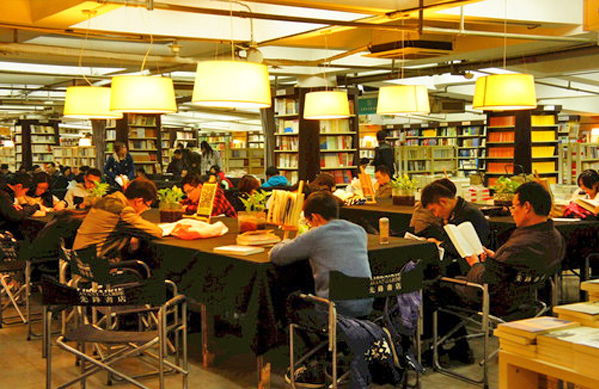Facing Internet competition, traditional bookstores evolve

Bookstores are facing new challenges from the Internet and are having to adapt with government assistance.
English writer William Somerset Maugham once said: “To acquire the habit of reading is to construct for yourself a refuge from almost all the miseries of life.”
At a corner of a city, a droplight, a cup of coffee, a piece of light music and a paper book allow you to settle in the armchair of a bookstore and indulge in a world constructed out of characters and imagery.
On Aug. 11, Beijing initiated a project that will allocate 18 million RMB to subsidize the establishment of local brick-and-mortar bookstores. The city is not alone: Shanghai, along with Jiangsu, Guangdong and Fujian provinces, have all launched new policies to encourage the development of local bookstores as well.
In April, the Chinese Academy of Press and Publication published the 13th national reading survey results. The results indicated that the frequency of reading for Chinese adults increased in 2015.
Literacy and reading habits have been promoted through a program called “nationwide reading” for over a decade, which has boosted book consumption. This trend has provided favorable conditions for the development of traditional bookstores across the country.
But the data reveals a more nuanced situation—the actual financial health facing book retailers fluctuates with time, even though both online and offline book sales, in a general sense, remain steady. Although online bookstores have maintained solid growth, brick-and-mortar bookstores still face various challenges.
In light of this situation, traditional bookstores have had to adapt.
They have chosen various different methods. They are adopting various forms of development that are part and parcel of retail business strategies, and are also utilizing an “Internet Plus” strategy which allows them to remain open 24 hours each day.
Some bookstores have formed an all-in-one retail model with book sales, food and beverage services, cultural activities and the sale of accessories.
The key characteristic of the rise of traditional bookstores is that some are taking advantage of this opportunity to establish chain bookstores and extend their scale of operation.
Many large bookstores, like Fang Suo Commune and Eslite Bookstore, have extended their business with steady steps, and their development is drawing public attention. More and more traditional bookstores are exploring diversification and becoming diverse spaces for cultural experiences.
Some bookstores focus on market niches and consumers’ experience at stores, and emphasize consumer demand. These kinds of stores are growing in number.
Compared to their expansion, this transformation is a more urgent task for bookstores, though many of them are still exploring transformation models. Some analysts indicate that traditional bookstores are just beginning to rise but haven’t really revitalized the industry. Government support and improved business practices will boost these bookstores.
Even as traditional bookstores are grappling with the impact of the Internet, online booksellers are moving in to traditional bookstore territory. Last November, Amazon’s first brick-and-mortar bookstore Amazon Books opened in Seattle. Later, Dangdang announced that it would open 1,000 offline bookstores across China over the following three years.
In this transformation process from traditional bookstores to cultural spaces, many scholars warn of the concept of “cultural estate” in which empty buzzwords are used to paper over uneven development of these places.
Although the emergence of the Internet and social economic changes have brought about many challenges to traditional bookstores, these stores still take every chance to realize business expansion and are open to embracing opportunities.

 PRINT
PRINT CLOSE
CLOSE